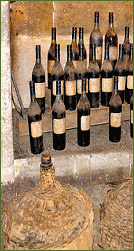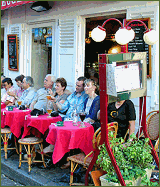|
You can find many great value wines in France and the variety you
can purchase is often quite mind boggling, right through from specialist wines, from the
unusual to the fortified, through to liqueurs and the traditional, but it can be great fun
trying the different varieties available in almost every region you encounter on your holiday to France.
Mind you, there are also some very expensive wines, that the vast majority of people in
the world will never be able to experience in their lifetime!
But with such a variety of wines to choose from, you really need to know what type of wine
you like, whether it be red or white, dry or sweet, fruity or full bodied, or even
sparkling wine or champagne, the choice is
immense as is the difference in cost from one particular wine to another.
If you see the word Degustation, it means that the owners of the vineyard are willing to
let you taste different wines that they have produced, although bear in mind that it is a
moral code of practice that at the end of a tasting session, you should always buy a few
bottles of your favourite that you tried out of courtesy.
But never feel that you will be pressured into buying something you do not like, most,
especially from the smaller vineyards are very friendly and helpful, although it can
sometimes be an advantage to know a little French before attempting to go to some of the
smaller growers, as you may even have to just knock on the door, rather than the more
commercial growers that have specific wine tasting sessions.
Always try to understand exactly what type of wine you are trying, so that you will know
what to look out for that will suit your palette, especially when you come to order a wine
at the local restaurant to accompany your food.
Of course, rather than a trip to the local wine grower, you can book specific wine tasting
holidays and weekend breaks with one of the more
popular destinations being the Bordeaux region, which is home
to some really aristocratic wines and what could be better than sitting in the shade at a
vineyard on a hot summers day, experiencing the wines and learning about the traditions
and how it is made.
There is no true correct way of wine tasting, but there are some basic principles that are
used and these will also help you to evaluate the wine. You should always start with
a clear wine glass and the rim should bend inwards to help with aromas going to your nose,
plus swirl the wine without spilling it.
Most places will pour the wine for you, but if not you should not poor more than around 2
to 3 centimetres and you need to begin with the lightest wines such as the sparkling wines
through to full bodied whites and then progress to the through the reds from the light to
the full bodied reds, then followed by dessert wines, which will help keep your taste buds
more sensitive so you can better appreciate each wine in the series. Some
places also provide water for you to sip in between so as to conserve the palette.
You should swirl the wine a couple of times by holding the stem and moving the glass in a
circular motion, which allows the wine to aerate. And although you can swallow a
small amount if you wish, especially if you want to know what the taste is like after it
has gone down, if you are in a complete wine tasting session, then you will normally be
provided with a container for you to spit out the wine.
But at the end of the day, you should have found a wine that smells good, tastes even
better, suits your palette and will accompany a meal with ease
|
|



